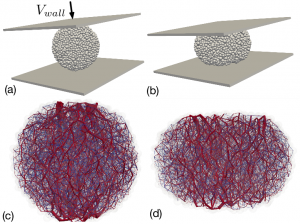Emilien Azéma, Paul Sánchez, and Daniel J. Scheeres. Physical review E (Rapid Communication) 98 030901(R) (2018)

Snapshots of a simulated granular asteroid under diamet- rical compression for (a) εh = 0 and (b) εh = 0.1. Force chains are represented by lines joining the centers of two touching particles. Compressive forces in red, and tensile forces in blue.
By means of extensive three-dimensional contact dynamics simulations, we analyze the strength properties and microstructure of a granular asteroid, modeled as a self-gravitating cohesive granular aggregate composed of spherical particles, and subjected to diametrical compression tests. We show that, for a broad range of system parameters (shear rate, cohesive forces, asteroid diameter), the behavior can be described by a modified inertial number that incorporates interparticle cohesion and gravitational forces. At low inertial numbers, the behavior is ductile with a well-defined stress peak that scales with internal pressure with a prefactor ≃ 0.9. As the inertial number increases, both the prefactor and fluctuations around the mean increase, evidencing a dynamical crisis resulting from the destabilizing effect of particle inertia. From a micromechanical description of the contact and force networks, we propose a model that accounts for solid fraction, local stress, particle connectivity, and granular texture. In the limit of small inertial numbers, we find a very good agreement of the theoretical estimate of compressive strength, evidencing the major role of these structural parameters for the modeled aggregates.